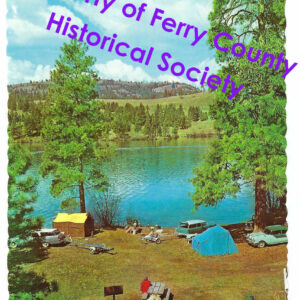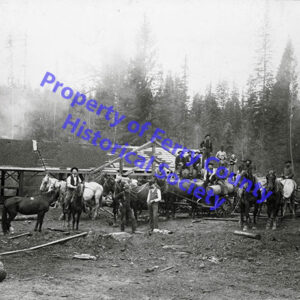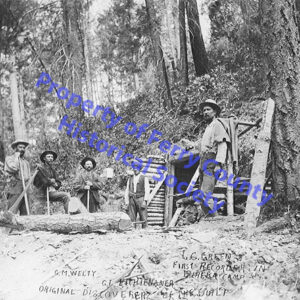By Madilane Perry, Ferry County Historical Society
Selections from the Republic News-Miner for Thursday, September 6, 1923
There are two page 1 articles in this issue, each taking up a full column, that were promised in the previous issue. One is the article by T.A. Bonsor, dealing with Republic’s fossils, the other deals with birds along the Sanpoil.
========================
Valley Is Rich In Pre-historic Remains
The Republic Region Once the Home of a Varied and Luxuriant Vegetation.
By T. A. Bonsor, Curator of Spokane Museum
When a person views the tree vegetation of the region surrounding Republic, he can hardly realize that several million years ago a lake occupied the site of Republic and that a sub-tropical forest of unusual luxuriance once encircled it. The streams emptying into the lake (which we shall christen Lake Republic) carried in vegetable material which became embedded in the clay at the bottom of the lake, and this material formed the fossils that are found in the shale deposits of the Republic region.
In fact, during the Tertiary age, subtropical forests flourished in practically all the area around the North Pole.
One of the most unique trees of that age was the Ginkgo or Maiden-hair-fern tree, of which a single species has survived to the present time, while during the tertiary age a large number of species of Ginkgo trees grew in various parts of the tertiary sub-tropical forests. Several of the species occurred in the vicinity of Republic. The leaves of these trees were four-shaped and have the same peculiar veining that that we find in the true ferns. Thus the tree seems to form the connecting link between the tree-ferns and our present-day cone-bearing tree, as our pines, firs, spruces, etc. Fossil Guinkgo leaves of various species have been reported from the John Day Basin, Oregon; Judith Basin, Montana; Spokane, Washington; Alaska; Greenland; Iceland; Spitz-bergan, Franz-Joseph Land and Scotland; thus showing its wide distribution during the Tertiary age. These stately trees with their peculiar leaves and plum-like fruit reared their crowns to the same sun that now gives light and life to all vegetation.
Another interesting series of trees were the Sequoias or giant Redwoods, two species of which have survived to the present day in California, while in the tertiary age, there were over 100 species. A number of species of these forest giants also graced the highlands around Republic, the most abundant species being the narrow-leaved Sequoia.
Besides these two interesting groups of trees there occurred the hardwood trees as oaks, maples, sycamores, walnuts, chestnuts, sweet gums, laurels, poplars, magnolias, red buds, and many other species now extinct.
Among the softwoods occurred the pines, cedars, yews, cypress and others.
The Republic region fortunately also possesses a mineral wealth of a still earlier age.
Fish also occurred in Lake Republic, as the exceedingly fine specimens of fossil fish testified which Mr. W. G. C. Lanskail, the superintendent of the Quilp Gold Mining Co. sent to our museum, in a shipment of fossil leaves from the Republic region.
This shipment induced the writer to make a personal visit to the region.
The Spokane Museum will devote an entire case to exhibits or ores, minerals, and fossils from the Republic region. All persons having such specimens may turn them over to Mr. Lanskail who will ship them to us for proper display in the special case devoted to that purpose. Thousands of visitors annually visit the museum, and in this way Republic will receive due publicity, which she justly deserves.
===================================
Naturalist Interested In Local Conditions
Bird Life Along the San Poil Interesting to the Enthusiastic Naturalist
Our party of three consisting Mr. T. A. Bonsor, Professor of Natural Science in the North Central high school and Curator of the Public Museum, Mr. J. L. Sloanaker, Ornithologist and Professor of Chemistry at the same school in Spokane, and myself. We started from Spokane by automobile on the morning of the 22nd of August, on a trip of 350 miles, via Wilbur, Keller, Republic, Grand Forks, B. C., Laurier, Marcus and back to Spokane. We arrived home on the evening of the 26th without a mishap, weather excellent and everything else propitious. We all agreed that the outing was about the most delightful within our experience. The principal objects of the expedition were to study the birds on the way and to examine and collect specimens of the prehistoric plant fossils embedded in the rock strata in and around the town of Republic.
The scenery along the San Poil was magnificent, equal, if not superior, to anything found elsewhere in the United States. The valley is narrow, bounded by high mountains and precipitous Cliffs hundreds of feet high.
The hills rock-ribbed and ancient
in the sun,
The vales stretching in pensive
slumber between.
Around the bases of these we threaded our laborious way over the most execrable road in the State of Washington, a disgrace to the community. However, the U. S. postoffice department has recently established a mail route with the promise that it will be improved before long. When this is done, it will be one of the most popular tourist routes in the state.
The bird-life of the valley is notaple for the great number and variety of species. Along the road and at our camping stations, we made minute records for the birds observed. There were Mountains Bluebirds, Kingbirds, Chipping Sparrow, Song Sparrow, Song Sparrow, Ducks of several varieties, Turtledove, several species of hawks, Crows, flicker, Nighthawk, Kingfisher, Sandpiper, Ruffed grouse, Magpie, Towhee, Cassin Vireo, Warblin Vireo, ,Red-eyed Vireo, Robin, Lewis Woodpecker, Wood Pewee, Pine Siskin, Red-breasted Nuthatch, Catbird, Chickadee, Northern Pileated Woodpecker, Western Evening Grosbeak, Redstart, Yellow Warbler, Audubon Warbler, Lutescent Warbler, Great Horned Owl, Short-Eared Owl, and some others whose identity we could not sufficiently prove and which, therefore, we did not record.
While we stopped at Keller about the middle of the afternoon to secure some supplies, a flock of 300 or 400 night hawks or “Bull-bats” as named by the natives, passed overhead on their way south. They were weaving back and forth through the air in pursuit of insect prey but with a general southward trend. The flock must have included the about the nighthawk population of the San Poil valley as we saw no others until we were descending the Kettle River below Grand Forks. At Keller, also crows were numerous, flying about in flocks, perching on tall pines, cawing and making much ado as if preparing for the fall migration. We saw probably a thousand. As we proceeded up the valley, many stragglers were hastening to join the main body. Kingfishers were abundant, going in pairs, or more, and being much in evidence all the way up the stream which we followed to its source. Ruffed grouse in flocks frequently crossed our path, whirring away into the thickets at our approach. There were hundreds of pine siskins, a small brown bird with yellow rump related to the goldfinch, feeding by the roadside on the thistles and other seed producing plants. Lewis woodpeckers were unusually numerous. They nest early in the season n holes in dead evergreens high up. The Northern Pileated Woodpecker is the largest of the woodpecker family, measuring seventeen inches. It is distinguished by its flaming throat and white streak down the side of the throat and breast. The rest of the body is black, the wing coverts being faintly marked with pale edgings. These birds are becoming rare, being found mostly in the wilder regions, where undisturbed by human contact. They should be protected as they feed on the insect enemies of the forest trees. The western evening grosbeaks generally breed further north and we do not find them in Washington very often before November when the winter storms drive them south. There were fifteen in the flock we saw, probably two families, feeding on hawthorn berries beside the San Poil. The Lutescent Warblers of which we saw twelve in a flock are also of infrequent occurrence in our experience as they breed mostly on the Pacific coast district west of the Cascades, from Oregon to Alaska. The owls, being night prowlers, we did not see, but their familiar hooting was heard and recognized every night in the nearby forest. There were some birds we expected to see which we did not find. For instance, the Oregon Junco, a common bird of Spokane, was entirely absent. They may have been presenton our line of travel but we failed to see any. We saw no Goldfinches until we crossed the Columbia River on our way home.
We spent a very enjoyable day and a half at Republic and then proceeded over excellent roads to Grand Forks. The highways in Canada from Danville to Laurier are magnificent, a credit to any Country.
WALTER BRUCE, President of the Spokane Bird Club





